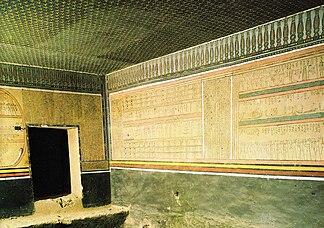Amduat
[3] Many gods, goddesses, and deities help both Ra and the deceased soul on this journey in a variety of ways, such as Khepri, Isis, and Osiris being some of the main ones.
The Amduat names all of these gods and monsters, such as the serpent of Mehen or the 'World Encircler' which play a variety of roles to either help or harm Ra and the deceased soul.
[4] The middle horizontal register traditionally starts with Ra on his solar barque (a type of boat), entering a new realm or ‘hour’ of the underworld.
As such, it is often known as a 'place of opposites,' which is best represented in hour 5 with the waters of Nun (the river that in the underworld is called the 'Wernes', but is the Nile in the land of the living) intermingling with the desert sands of Sokar.
The upper and lower registers contain a labeled list of the common and/or important creatures and beings found within the underworld.
[8] Hour 2: This is when Ra officially enters the underworld on his barque along with four other boats beside him, leaving the transition between life & death or between day & night.
This hour stresses fertility, represented both by the waters of Nun and the unnamed gods of the lower register who are all associated with images of agriculture and farming.
Ancient Egyptians believed that the Nile was sourced from the underworld, and so Osiris's inclusion at this point of the journey makes sense when considering he is the god of the afterlife, as well as fertility and agriculture.
At this point, the sungod has reached deep enough into the underworld and away from his own light that he cannot see, having to rely on his own voice as a way to guide himself and his crew out of the darkness.
[11] There is a narrow passage-way that it is attempting to get through, resulting in all of the friendly beings of this regions (including the scarab representation of Khepri) helping to pull the boat.
An oval representing the 'Cavern of Sokar' is present on the bottom register with the god himself being contained by a lake of fire surrounding the cavern.
In this hour, Apep swallows all of the waters of Nun in an attempt to stop the barque and kill Osiris through Ra once more, preventing the daily cycle of the sun.
[13] The goddess Isis places a magic spell upon the barque in order to allow it to continue traveling through the regions without the need for water.
The three idols present in front of the men are there to help the gods carrying stalks of grain disperse bread and beer to the dead in the underworld.
On the lower register is an image of those who drowned in water being pulled to shore by Horus, the god of the sky (in addition to many other things).
[17] Horus calls upon a monstrous serpent with the unquenchable fire to destroy the enemies of his father, Osiris, by burning their corpses and cooking their souls.
There are no agreed upon descriptions for the purposes of these rooms and what was contained inside of them, with historians like Erik Hornung and Friedrich Abitz attempting to explain them in their respective academic pursuits.
As discussed by Historians Catherine Roehrig and Barbara Richter, the architecture of Thutmose III's tomb is likely meant to mirror the structure of the underworld as the Amduat displays it.
[4] Found within the burial chamber of the pharaoh, the Amduat was a guide for him to follow through the underworld, as well as a way to achieve rebirth for himself after death.
It is notable that Useramun's tomb only contained the images of hours 3 and 4, not the whole journey of the sun which only adds to the exclusivity of the Amduat to royalty in Ancient Egyptian funerary traditions.
[6] At the end of the New Kingdom, the Amduat seems to have lost its exclusivity, appearing on both coffins and papyri for deceased people of a lower class than royalty or nobility.



